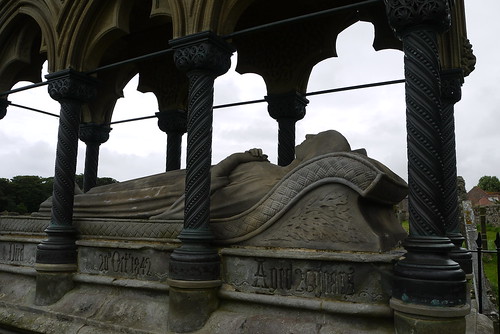Within St Aidan’s churchyard stands an effigy to Grace Darling:
Grace Horsley Darling was born on 24th November 1815 in her grandfather’s cottage here in Bamburgh. She was the seventh child of nine. At only three weeks old she was taken to live on Brownsman Island, in the Farne islands, where her father, William was lighthouse keeper. In 1816 the family moved to a new lighthouse on Longstone.
At four in the morning on 7th September 1838 during a violent storm, the steamship Forfarshire struck the Big Harcar rock on the Farnes, and over 40 lives were lost.
Grace saw the wreck, half a mile from the Longstone, and at 7 a.m. spotted survivors. William Darling thought the conditions would prevent the launching of the Seahouses lifeboat, so together he and Grace launched their coble in the atrocious weather. The strength of the tide and wind forced them to row nearly a mile to avoid the jagged rocks and reach the survivors. Here William went ashore while Grace alone kept the coble in position. Rowing against the tide and the gale, they took five survivors back to the lighthouse. William and two of the crew then returned to fetch the rest.
National Heroine
Numerous newspaper articles reported the rescue and Grace soon became a national heroine. The times asked the question, “Is there in the whole field of history, or of fiction even, one instance of female heroism to compare for one moment with this?”
Books and poems were written about her, portraits often painted and offers of marriage made. The publicity she received was overwhelming.
On 20th October 1842, only four years after the famous rescue, Grace died of tuberculosis. In 1844 the public raised money to build a monument in St. Adain’s Churchyard overlooking the sea. Queen Victoria being the first to contribute to it’s cost.
The effigy of Grace with a coble’s oar was sculpted of Portland stone which weathered very quickly. In 1885, at a cost of approximately £100, it was replaced with a replica sculptured in local stone, and the original moved into the Church. In 1893, the stone pitched canopied roof was destroyed in a violent storm. This was replace with a canopy of a new design.
To this day Grace remains a national heroine and Nothumbria’s most famous daughter.*
*From a signboard next to the effigy.











She was always a heroine of mine, so it’s nice to see this memorial to her.
I have to confess that although I had heard of her I didn’t know her story until I visited this Churchyard.
She seems to have been a remarkable woman, anyway.
Now I have read her story, I agree she was a remarkable young woman
i read about her in school for some english work we had to do in fourth grade. i remember being very fascinated about her ever since.
Her story is interesting
This must be the first time you’ve written of Northumbria, Cherie.
Nortumbria/Northumberland is a common theme on my blog. It feels like home to me.
Keep up